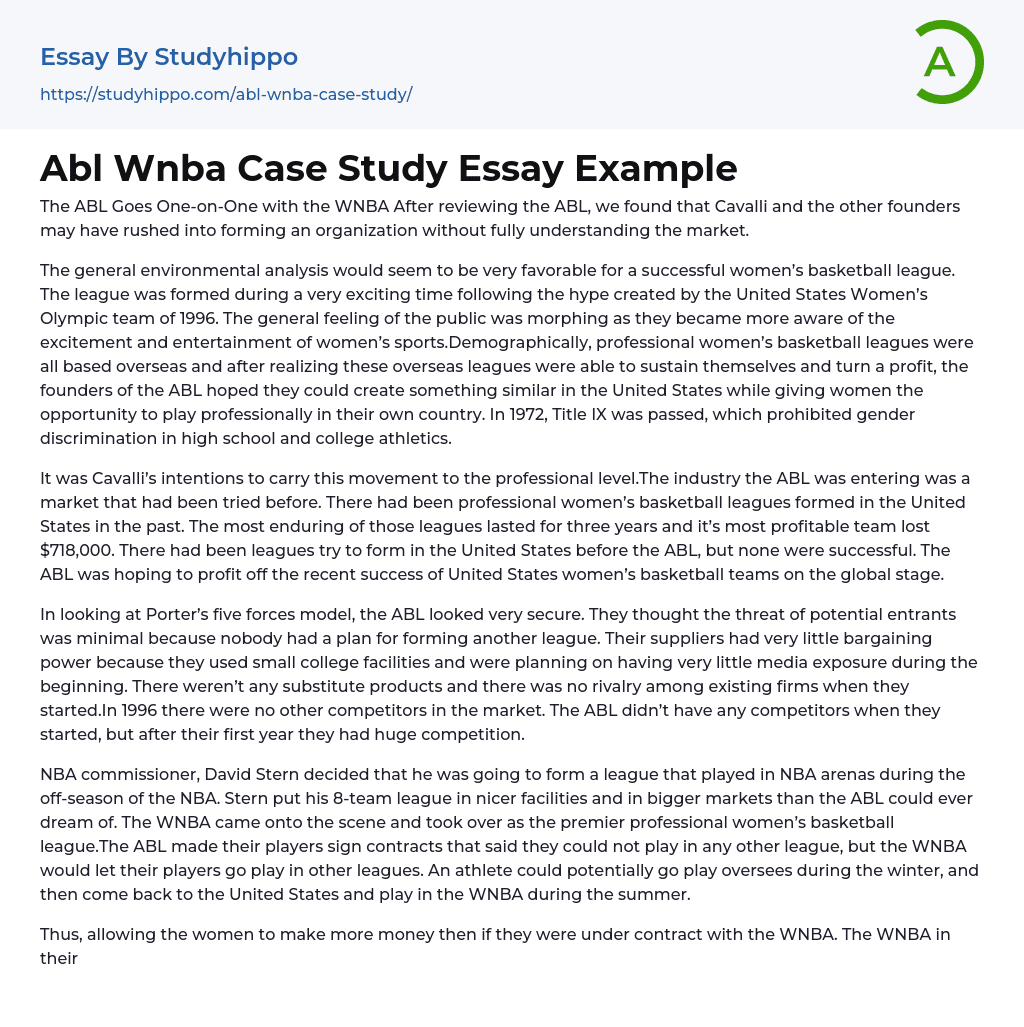When considering the ABL's interaction with the WNBA, it was revealed that Cavalli and other founders may have hastily established an organization without fully understanding the industry.
The prospects for a successful women’s basketball league appear to be highly promising based on the overall environmental analysis. The league was established amidst great enthusiasm, following the trend generated by the 1996 United States Women’s Olympic team. The public’s perception was shifting as they became more cognizant of the thrill and amusement of women's sports. The professional women's basketball leagues were entirely situated overseas in terms of demographics and recognizing their ability to maintain their stability and profitability, the founders of the ABL aimed to create something similar domestically, affording women the chance to play professionally in their native land. The passage of Title IX in 1972 barre
...d gender-based discrimination in high school and college athletic programs.
Cavalli aimed to elevate this movement to a professional level, entering a market that had previously been attempted. Despite past efforts to form professional women's basketball leagues in the United States, including a three-year successful league that had its most profitable team lose $718,000, no leagues had prospered. However, the ABL intended to capitalize on the recent triumphs of US women's basketball teams at an international level.
When the ABL analyzed Porter’s five forces model, they concluded that their league was highly secure. The possibility of new competitors entering the market was deemed minimal because no one had devised a plan for creating another league. Suppliers had little leverage over the ABL because the league utilized modest college facilities and did not expect much media exposure in the early stages. The
absence of substitute products and rivalry among existing firms at the onset of operations further reinforced this security. Initially, the ABL operated with no competitors in 1996. However, they faced significant competition after their first year.
During the NBA off-season, a league was established by NBA commissioner David Stern which played in NBA arenas. This league comprised of eight teams and had better markets and facilities as compared to the ABL. The WNBA became superior to the ABL as it emerged as the leading women's professional basketball league. Unlike the ABL, players were not bound by contracts preventing them from playing in other leagues, allowing them to participate in other leagues such as playing overseas during winter and returning for the summer WNBA season.
Comparatively, the WNBA provided women with greater potential earnings than they would have received through a contract with the ABL. In their debut season, the WNBA outperformed any previous year of the ABL. This was reflected in higher average attendance figures at WNBA games - three times that of ABL games - with 9,669 attendees compared to 3,536. Moreover, players in the WNBA enjoyed an average annual salary of $80,000 while those in the ABL were offered an average salary of $30,000.
The ABL possessed a significant competitive edge with eight contracted players from the 1996 Olympic team, whereas the WNBA only had four players under contract. Nevertheless, three of the four players the WNBA had under contract were starters on the Olympic team. Despite the ABL's marketing shortcomings, the WNBA thrived by utilizing the NBA's established media outlets to promote their league effectively.
- Chief Executive Officer essays
- Convenience Store essays
- Firm essays
- Training And Development essays
- Unilever essays
- Variable Cost essays
- Virgin Group essays
- Bargaining essays
- Entity essays
- Pest analysis essays
- Advertising essays
- Audience Theory essays
- Competitor Analysis essays
- Consumer essays
- Marketing Management essays
- Marketing Mix essays
- Marketing Plan essays
- Marketing Research essays
- Marketing Strategy essays
- Point Of Sale essays
- Price essays
- Procurement essays
- Product essays
- Product Differentiation essays
- Promotion essays
- Promotion And Marketing Communications essays
- Retailing essays
- Trademark essays
- Anheuser-busch essays
- Brands essays
- Detergent essays
- Product Placement essays
- Research Design essays
- New Product Development essays
- Advertisement essays
- Brand essays
- Sales Promotion essays
- Advertising campaign essays
- Consumer behaviour essays
- Offer And Acceptance essays
- Wal-Mart essays
- Discover essays
- Fight club essays
- Training essays
- Athletic Shoe essays
- Gym essays
- Yoga essays
- Baseball essays
- Basketball essays
- Bodybuilding essays




